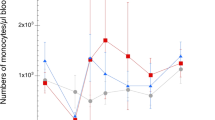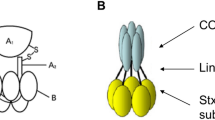Abstract
The serum antileukotoxin antibody response and protection against subsequent experimental challenge with Fusobacterium necrophorum were investigated in 30 steers vaccinated with crude F. necrophorum leukotoxoid. Culture supernatant of F. necrophorum, strain 25, containing leukotoxoid was concentrated. The steers were assigned randomly to six groups (n=5): PBS control with Stimulon adjuvant; vaccinated with concentrated supernatant diluted to provide 2.5, 5.0, 10.0, or 20.0 ml with the watersoluble Stimulon adjuvant; and 5.0 ml with the Ribi oil-emulsion adjuvant. The steers were injected subcutaneously on days 0 and 21. Blood samples were collected at weekly intervals to monitor serum antileukotoxin antibody titres. On day 42, all the steers were challenged intraportally with F. necrophorum culture. Three weeks later (day 63), the steers were killed and necropsied for examination of their livers and assessment of protection. Steers vaccinated with crude leukotoxoid tended to have higher antileukotoxin titres than the controls, but the difference was not significant. Also, the antibody titre did not appear to be dose-dependent. In the control group, 3 out of 5 steers developed liver abscesses. The incidence of liver abscesses in steers vaccinated with Stimulon adjuvant was not dose related; however, only 8 of the 25 vaccinated steers developed abscesses. None of the steers vaccinated with the 5.0 ml dose with Ribi had any abscesses. Evidence for a relationship between antileukotoxin antibody and protection was shown by the lower titre in those steers that developed abscesses compared to those that did not. It was concluded that antileukotoxin antibody titres probably provided some degree of protection against experimentally induced liver abscesses, but further dose-titration studies using Ribi or possibly another more effective adjuvant will be needed to confirm this.
Similar content being viewed by others
Abbreviations
- BHI:
-
brain-heart infusion
- CFU:
-
colony-forming units
- ELISA:
-
enzyme-linked immunosorbent assay
- MTT:
-
3-[4,5-(dimethylthiazol-2-yl)]-2,5-diphenyltetrazodium] bromide
- PBS:
-
phosphate-buffered saline
- PMN:
-
polymorphonuclear neutrophils
References
Berg, J.N. and Scanlan, C.M., 1962. Studies of Fusobacterium necrophorum from bovine hepatic abscesses: biotypes, quantitation, virulence, and antibiotic susceptibility. American Journal of Veterinary Research, 43, 1580–1586
Brink, D.R., Lowry, S.R., Stock, R.A. and Parrott, J.C., 1990. Severity of liver abscesses and efficiency of feed utilization of feedlot cattle. Journal of Animal Science, 68, 1201–1207
Brown, H., Bing, R.F., Grueter, H.P., McAskill, J.W., Cooley, C.O. and Rathmacher, R.P., 1975. Tylosin and chlortetracycline for the prevention of liver abscesses, improved weight gains and feed efficiency in feedlot cattle. Journal of Animal Science, 40, 207–213
Clark, B.L., Emery, D.L., Stewart, D.J., Dufty, J.H. and Anderson, D.A., 1986. Studies into immunization of cattle against interdigital necrobacillosis. Australian Veterinary Journal, 63, 107–110.
Coyle-Dennis, J.E. and Lauerman, L.H., 1979. Correlations between leukocidin production and virulence of two isolates of Fusobacterium necrophorum. American Journal of Veterinary Research, 40, 274–276
Emery, D.L. and Vaughan, J.A., 1986. Generation of immunity against Fusobacterium necrophorum or mice inoculated with extracts containing leukotoxin. Veterinary Microbiology, 12, 255–268
Emery, D.L., Duffy, J.H. and Clark, B.L., 1984. Biochemical and functional properties of a leukocidin produced by several strains of Fusobacterium necrophorum. Australian Veterinary Journal, 61, 382–386
Emery, D.L., Vaughan, J.A., Clark, B.L., Duffy, J.H. and Stewart, D.J., 1985. Cultural characteristics and virulence of strains of Fusobacterium necrophorum isolated from the feet of cattle and sheep. Australian Veterinary Journal, 62, 43–46
Garcia, M.M., Dorward, W.J., Alexander, D.C., Magwood, S.E. and McKay, K.A., 1974. Results of a preliminary trial with Sphaerophorus necrophorus toxoids to control liver abscesses in feedlot cattle. Canadian Journal of Comparative Medicine, 38, 222–226
Jensen, R., Deane, H.M., Cooper, L.J., Miller, V.A. and Graham, W.R., 1954a. The rumenitis-liver abscess complex in beef cattle. American Journal of Veterinary Research, 15, 202–216
Jensen, R., Flint, J.C. and Griner, L.A., 1954b. Experimental hepatic necrobacillosis in beef cattle. American Journal of Veterinary Research, 15, 5–14
Kanoe, M., Ishii, T. and Kai, K., 1987. Effects of Fusobacterium necrophorum leukocidin on bovine ruminal cells in vitro. FEMS Microbiology Letters, 35, 119–123
Langworth, B.F., 1977. Fusobacterium necrophorum: its characteristics and role as an animal pathogen. Bacteriological Reviews, 41, 373–390
Lechtenberg, K.F. and Nagaraja, T.G., 1991. Hepatic ultrasonography and blood changes in steers with experimentally induced liver abscesses. American Journal of Veterinary Research, 52, 803–809
Lechtenberg, K.F., Nagaraja, T.G., Leipold, H.W. and Chengappa, M.M., 1988. Bacteriologic and histologic studies of hepatic abscesses in cattle. American Journal of Veterinary Research, 49, 58–62
Potter, E.L., Wray, M.I., Muller, R.D., Grueter, H.P., McAskill, J. and Young, C., 1985. Effect of monensin on average daily gain, feed efficiency and liver abscess incidence in feedlot cattle. Journal of Animal Science, 61, 1058–1065
Roberts, D.S., 1967. The pathogenic synergy of Fusiformis necrophorus and Corynbacterium pyogenes. I. Influence of the leukocidal exotoxin of F. necrophorus. British Journal of Experimental Pathology, 48, 665–673
Roberts, D.S., 1970. Toxic, allergenic and immunogenic factors of Fusiformis necrophorus. Journal of Comparative Pathology, 80, 247–257
SAS. 1987. SAS/STAT Guide for personal computers. (SAS Institute Inc, Cary, NC)
Scanlan, C.M. and Hathcock, T.L., 1983. Bovine rumenitis-liver abscess complex: a bacteriological review. Cornell Veterinarian, 73, 288–297
Smith, H.A., 1944. Ulcerative lesions of the bovine rumen and their possible relation to hepatic abscesses. American Journal of Veterinary Research, 5, 234–242
Smith, G.R. and Wallace, L.M., 1992. Further observations on the weak immunogenicity of Fusobacterium necrophorum. Research in Veterinary Science, 52, 262–263
Smith, G.R., Turner, A., Murray, L.G. and Oliphant, J.C., 1985. The weak immunogenicity of Fusobacterium necrophorum. Journal of Hygiene, Cambridge, 95, 59–68
Smith, GR, Wallace, LM and Till, D., 1989. Necrobacillosis and immunity in mice. Epidemiology and Infection, 103, 211–215
Takeuchi, S., Nakajima, Y., Ueda, J., Motoi, Y., Kobayashi, Y. and Morozumi, T., 1984. Hepatic abscess formation in cattle inoculated with Fusobacterium necrophorum. Japanese Journal of Veterinary Science, 46, 339–344
Tan, Z.L., Nagaraja, T.G. and Chengappa, M.M., 1992. Factors affecting the leukotoxin activity of Fusobacterium necrophorum. Veterinary Microbiology, 32, 15–28
Tan, Z.L., Lechtenberg, K.F., Nagaraja, T.G., Chengappa, M.M. and Brandt, R.T., 1994a. Serum neutralizing antibodies against Fusobacterium necrophorum leukotoxin in cattle with experimentally induced or naturally developed hepatic abscesses. Journal of Animal Sciences, 72, 502–508
Tan, Z.L., Nagaraja, T.G. and Chengappa, M.M., 1994b. Biochemical and biological characterization of ruminal Fusobacterium necrophorum. FEMS Microbiology Letters, 120, 81–86
Tan, Z.L., Nagaraja, T.G., Chengappa, M.M. and Smith, J.S., 1994c. Biochemical and biological characterization of Fusobacterium necrophorum leukotoxin. American Journal of Veterinary Research, 55, 515–521
Tan, Z.L., Nagaraja, T.G., Chengappa, M.M. and Staats, J.J., 1994d. Purification and quantitation of Fusobacterium necrophorum leukotoxin by using monoclonal antibodies. Veterinary Microbiology, 42, 121–133
Vega, M.V., Maheswaran, S.K., Leininger, J.R. and Ames, T.R., 1987. Adaptation of a colorimetric microtitration assay for quantifying Pasteurella haemolytica A1 leukotoxin and antileukotoxin. American Journal of Veterinary Research, 48, 1559–1564
Author information
Authors and Affiliations
Rights and permissions
About this article
Cite this article
Saginala, S., Nagaraja, T.G., Tan, Z.L. et al. The serum neutralizing antibody response in cattle to Fusobacterium necrophorum leukotoxoid and possible protection against experimentally induced hepatic abscesses. Veterinary Research Communications 20, 493–504 (1996). https://doi.org/10.1007/BF00396292
Accepted:
Issue Date:
DOI: https://doi.org/10.1007/BF00396292




